NV-Retriever: Improving text embedding models with efective hard-negative mining
[Retrieval] NV-Retriever: Improving text embedding models with efective hard-negative mining
- paper: https://arxiv.org/pdf/2407.15831
- github: X
- huggingface: https://huggingface.co/nvidia/NV-Retriever-v1
- archived (인용수: 1회, ‘25-04-06 기준)
- downstream task: MTEB (t2t retrieval, reranking, summarization, semantic textual similairity, clustering, classification)
1. Motivation
-
Embedding 모델을 finetuning할 때, false negative로 인해 고품질의 hard negative sample을 contrastive learning을 위해 추출하는 것은 어렵다.
$\to$ False negative을 teacher ensemble 기반으로 새로운 알고리즘을 적용해서 retrieval 학습을 수행해보자!
2. Contribution
- FN을 효율적으로 제거하여 retrieval accuracy를 향상시키는 postivie-aware hard-negative mining (HNM)기법을 제안
- 다양한 teacher / HNM 방법들에 대한 실험으로 retrieval model이 얼마나 hard-negative에 sensitive한지 분석
- MTEB에서 SOTA 성능을 보임
3. NV-Retriever
-
InfoNCE loss

- positive sample의 유사도는 maximize
- negative sample의 유사도는 minimize
-
Naive Top-K (Hard-negative mining)
- similar candidate 중 top-K개를 negative sample로 지정 $\to$ dataset에 따라, false negative (positive인데, negative로 잘못 label된 samples) 이슈
- 특히 검색을 수행하는 corpus가 클수록 해당 이슈는 심해짐
-
Top-K shifted by N
- N+1 ~ N+K 번째만 hard negative로 sampling $\to$ query와 negative간의 relavance score를 고려하지 못함. 또한 매우 가치있는 hard negative를 놓칠 우려가 있음
-
Top-K with absolute threshold (TopK-Abs)
- Absolute threshold보다 높은 similarity score 를 갖는 negative는 무시
-
[제안] 두가지를 제안함
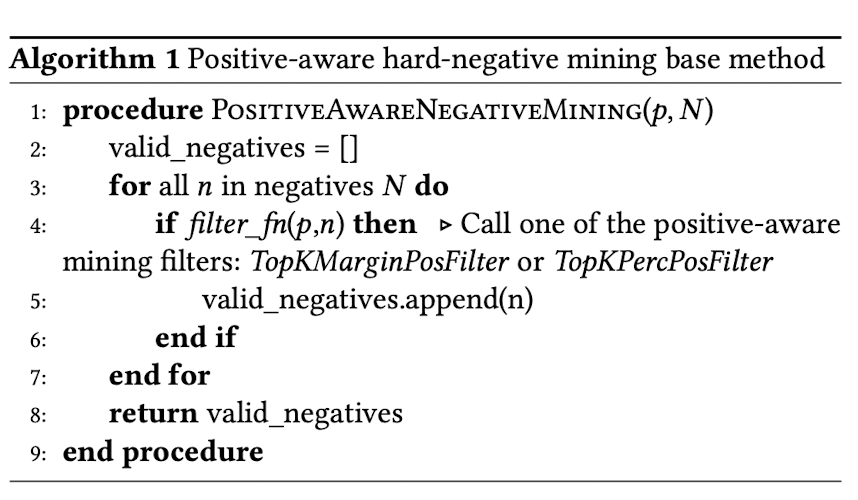
-
Top-K with margin to positive threshold (TopK-MarginPos)

- margin을 두고 max negative score는 positive - margin 보다 작아야함
-
Top-K with percentage to postivie threshold (TopK-PercPos)

- positive score보다 일정 percentage 이하로 낮아야함
-
4. Experiments
- baseline model: e5-large-unsupervised or Mistral-7B-v0.1 base
- dataset
- train: Natural Question, Stack exchange, SQUAD
- eval: MTEB Retrieval / BEIR benchmark (NQ, HotpotQA, FiQA-2018)
4.1 RQ1. Using different teacher model for mining
- Teacher model
- e5-large-unsupervised (334M param.): E5 model을 CL로만 학습
- e5-large-v2 (334M param.): 위 모델을 SFT
- snowflake-arctic-embed-l (334M param.): pretrain + SFT를 artic-embed model로 수행
- e5-mistral-7b-instruct (7.1B param.): decoder-only mistral with CL
- NV-Embed-v1 (7.8B param.): Mistral-based + bi-directional + latent attention
- Student model
- E5-large-unsupervised
- Dataset별로 각 teacher model이 할당되어 hard negative mining 수행
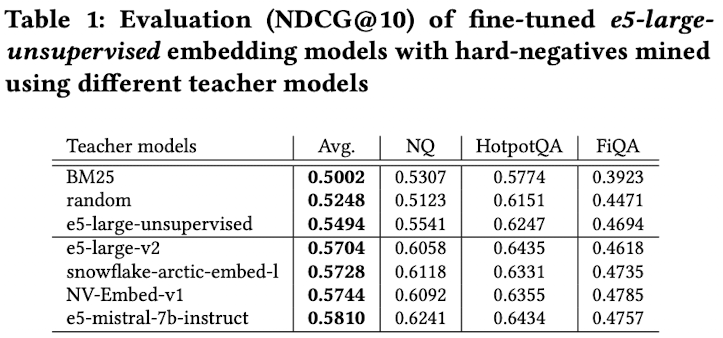
- e5-mistral-7b-instruct > NV-Embed-v1 > … > BM25
4.2 RQ2. Ensembling hard-negatives from different teacher models
-
Ensemble하게된 동기: Teacher 모델별로 hard-negative sampling한 결과가 서로 다름 (similarity < 30%)
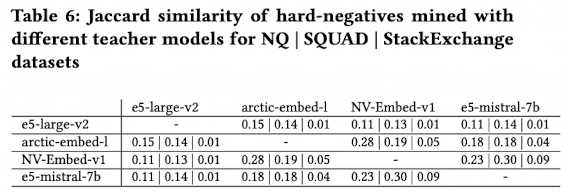
-
Ensemble 적용 방법 (2가지)
- Cross-sample ensembling: query별로 teacher를 sampling해서 해당 teacher의 hard negative로 학습
- Intra-sample ensembling: query별로 4개의 teacher별 top-1을 뽑아서 hard negative로 학습
- dedup: duplicated sample은 제외
- dup: duplicated sample도 포함
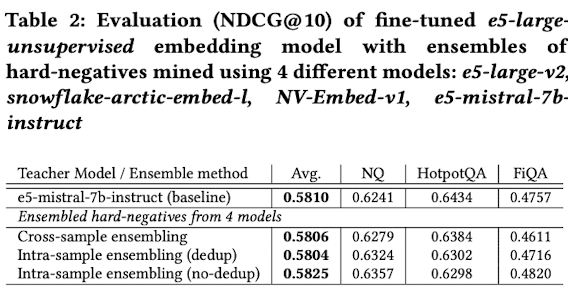
- Intra-sample (dup) > Intra-sample (de-dup) > Cross-sample > Single best teacher (baseline)
4.3 RQ3.a Comparing methods for mining hard-negatives
-
TopK-shifted by N vs. TopK-Abs vs. TopK-MarginPos vs. TopK-PercPos
-
baseline teacher model: e5-mistral-7b-instruct
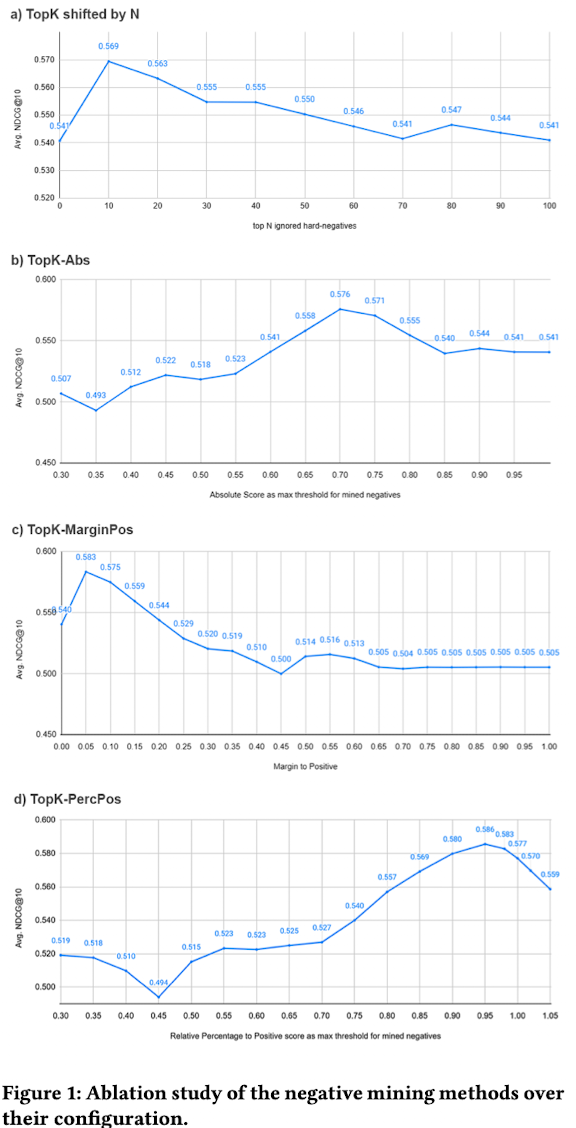
- TopK-PecPos > TopK-MarginPos > TopK-Abs > TopK shifted by N
-
Mined negatives에서 sampling하는 방법
-
Sampled Top-K: 상대적 다양성을 위해 top-k 중에서 randome하게 n개를 sampling
-
Top-1+sampled top-K: top-1 hard negative은 선택하고, top-k중에 나머지 n-1개를 sampling
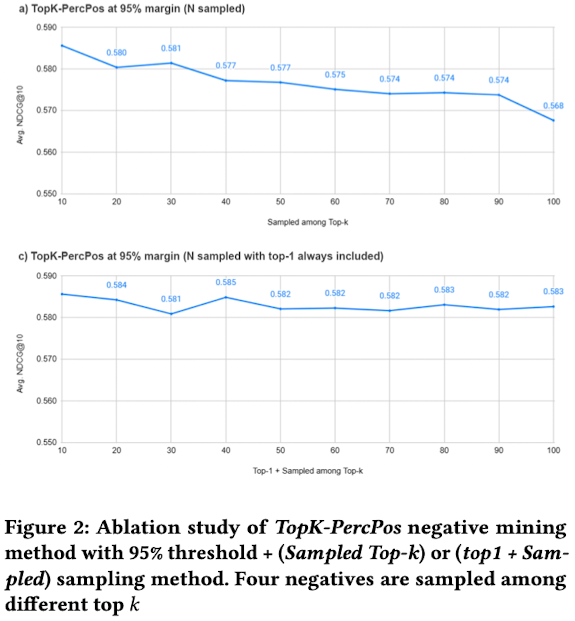
- Top-1+sampled top-K > Sampled Top-K
-
최상의 조합 결과
-
base model: e5-large-unsupervised
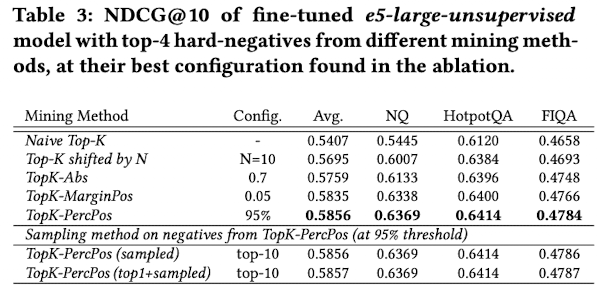
- Naive Top-K vs. TopK-PercPos: False Negative를 제거하는게 얼마나 중요한지 알 수 있음
-
base model: Mistral-7B-v0.1
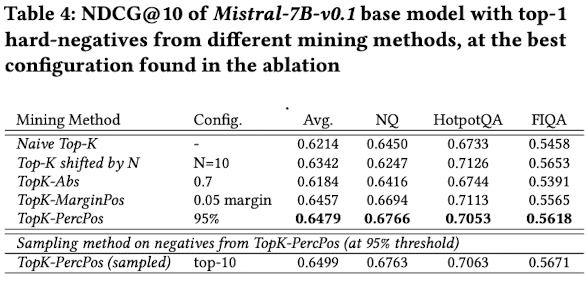
- Model이 좋아지니까 성능 향상폭이 더 크다
-
-
4.4 RQ3.b Comparing mining methods at scale with NV-Retriever-v1
-
모델
- student: Mistral-7B-v0.1
- teacher: E5-Mistral-7B
-
학습 파라미터
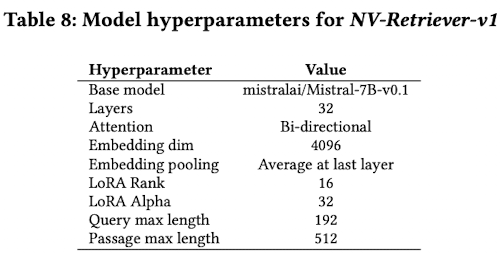
-
학습 데이터셋
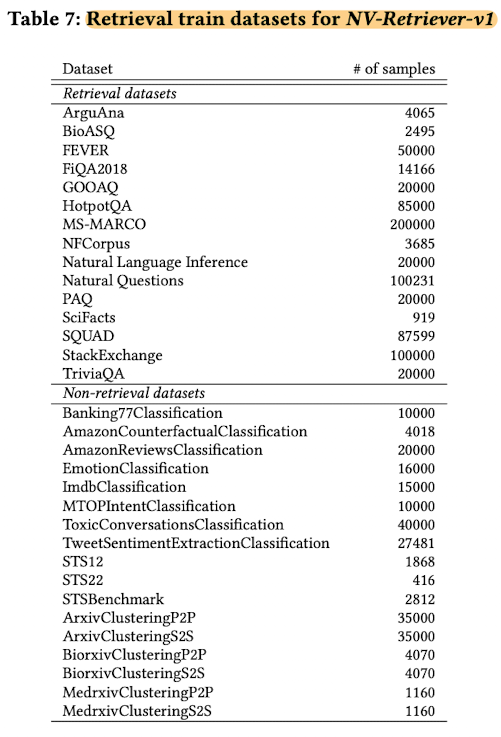
-
MTEB benchmark 결과
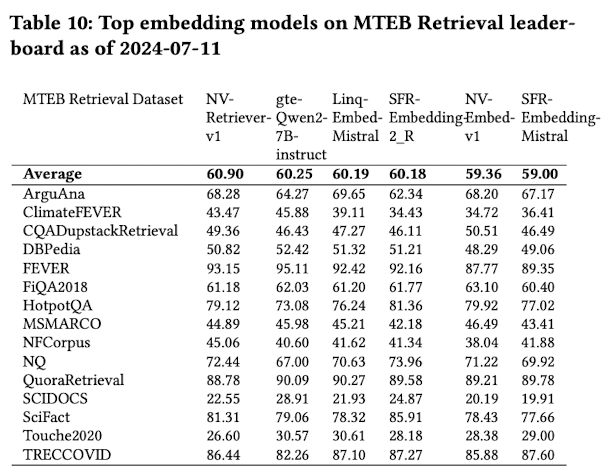
4.5 Effects of positive-aware neg. mining
-
LLM-as-a-judge를 통해 해당 알고리즘의 hard-negative와 naive-topK hard-negative 간의 query와 유사도를 비교함
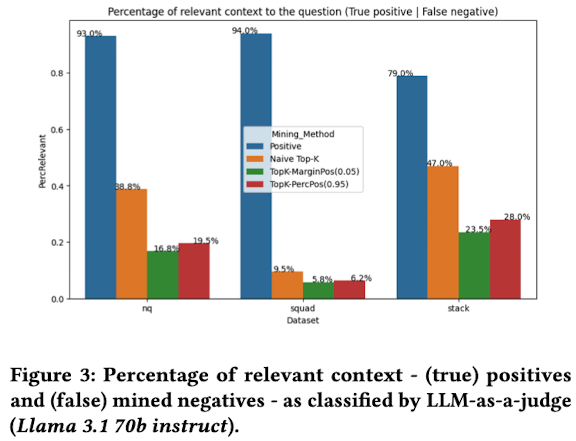
$\to$ 2배 이상 잘 걸러짐을 확인